|
EQUINE CLICKER TRAINING..... using precision and positive reinforcement to teach horses and people |
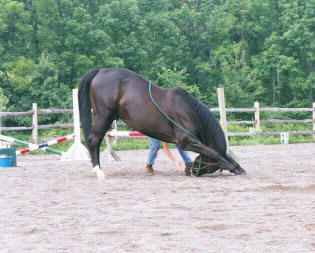
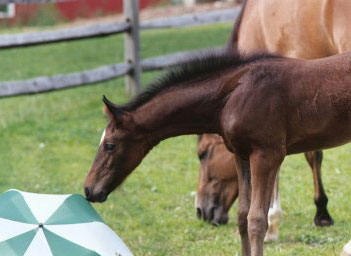
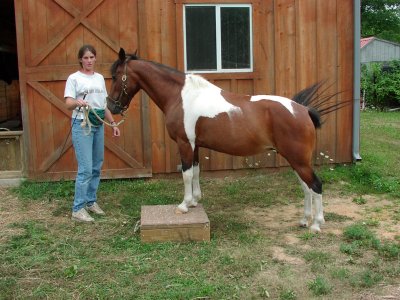
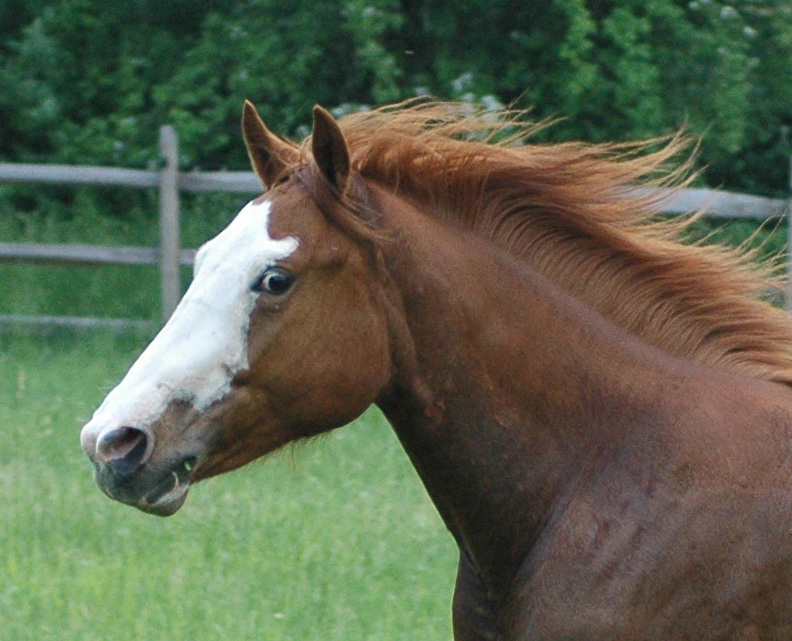
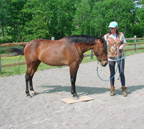
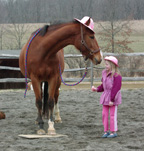
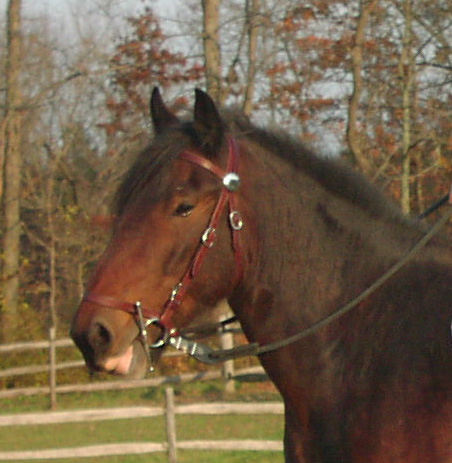
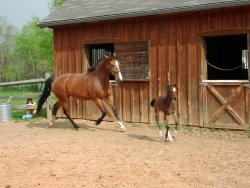 |
|
How To Use Different Food Delivery Techniques as Part of
Your Training
How you deliver food can have a big impact on the success of your training. This article will cover a number of aspects of food delivery including the items listed below:
∑ The Basics: general guidelines to keep in mind when delivering food ∑ A list of food delivery techniques and basic descriptions of each ∑ Instructions on how to introduce a new method of food delivery to your horse ∑ Some charts showing the effect of different types of food delivery on the foundation behaviors ∑ A brief description of feeding under saddle
∑ I will finish with some general comments and suggestions to help you be successful as you explore different ways of presenting the food.
The point of this article is to get you thinking more about how food delivery can be used to improve your training. My hope is that by reading about different techniques, you will become more observant about how your food delivery is affecting your training, learn to recognize different feeding techniques when used by other people, and give you some information about ways you can use food delivery to improve your training. Then, the next time you are working on a behavior or writing a training plan for a new behavior, you will be able to evaluate if your food delivery is working well for what you want to train. If you are just starting clicker training, you have hopefully already realized that teaching your horse to be polite around food and take it gently is essential to your success with this training method. Itís no fun to train (and not safe) if you donít take the time to make sure that the horse understands the food comes after the click and how to behave when you deliver it.
The BASICS:
There are some basic skills you need to have to be able to feed promptly and smoothly. A quick review of these before a session is often helpful for novice clicker trainers. Here are some key points about good food delivery:
Here are some basic guidelines for good food delivery:
Being consistent will make everything easier in the beginning. Once you and the horse are comfortable with basic food delivery, then you can start to explore some other food delivery options that speed up training the behaviors you want and minimize getting unwanted behaviors between the click and treat, or treat and next cue.
I am going to talk about a number of different ways to deliver food in this article. When reading about any of them, itís important to keep in mind that food delivery should always follow the basic guidelines above, even when using some of the more advanced techniques. If you see any confusion or mugging, it means you need to go back to a simpler or more familiar way of delivering food. Learning to use different methods of food delivery is a learning process for both horse and handler, so when things get not quite right, itís always a good idea to go back to an earlier step and review.
Before I get to the actual techniques, here are a few common questions and answers:
WHY NOT JUST FEED THE SAME WAY ALL THE TIME?
Since the click marks the behavior, you may wonder why it matters where the food is placed. It turns out that even though the click marks the behavior, everything between the click and treat is also reinforced, although with less precision and predictability. Most information on food delivery focuses on this part of the training cycle (between click and treat) because it has the most obvious impact on your training. It is usually where poor food delivery skills create problems, which often show up as unwanted behaviors. But food delivery can also affect other parts of the training cycle including what happens between the treat and the next cue or repetition. A wise trainer thinks about what behaviors they want to reinforce throughout the ENTIRE training cycle (cue -> behavior - > click -> treat -> cue.) Strategic placement of the food can help streamline what happens between the treat and the next cue or repetition of the behavior. Placement of the food can help put the horse in position to immediately repeat the clicked behavior so there is less chance of unwanted behavior creeping in or it can be used to make it easier for the horse to meet the criteria in the next repetition. In short, carefully planned and delivered food can speed up training behaviors you want and minimize the opportunities for other behavior to creep into your training loops.
The term ďdynamic food deliveryĒ comes from Alexandra Kurland who uses it to emphasize that food delivery is not a fixed process to be done the same way all the time. What happens between the click and treat is an important part of your training and should be used wisely. Strategic food delivery means thinking about the placement of the food so that it is being used effectively for the behavior, or aspect of the behavior you are training.
Both of these terms imply that the food delivery is an active and well thought out process and that the horse might be required to move to get to his food. This brings up two considerations. The first is that the horse should not have to do additional work to get his food, either by following it (as if lured) or by being asked to do another behavior. The way we avoid getting into either of these scenarios is by teaching the horse that the click is both a marker and cue. It means food is coming, and it also means he should check with the trainer to see where the food will be delivered.
We can train the horse that the click means stop and wait for your food, or we can train the horse that the click means stop (optional) and check with the handler to see where the food will be delivered. This second option is how I train my horses to respond to the click. It allows me to have a lot of flexibility in how I feed without frustrating them because they learn to read my body language to find out where the food will be delivered. This is a process and has to be taught like anything else.
The important distinction between food luring and dynamic food delivery is in the timing of when you present the food (open your hand) and how fluid and clear you are in your movement. In dynamic food delivery you click and immediately start moving to indicate where the food will be delivered. You open your hand and present the food when your hand has arrived at the place where you want to feed the horse. This is very different than opening your hand and luring the horse to a new location. Iíll explain a bit more about this later when I look at individual food delivery techniques.
ISNíT THIS LIKE ASKING FOR ANOTHER BEHAVIOR BETWEEN THE CLICK AND TREAT?
My general rule is that I will not ask for a behavior as part of a food delivery technique that the horse has not already learned and that is not directly related to directing him to find the food.
A LIST OF FOOD DELIVERY TECHNIQUES: These food delivery techniques are mostly used when shaping new behaviors. For finished behaviors, I tend to feed in my default feeding position which is with the head and neck lined up between the shoulders and at a normal height and posture. Some of these terms are ones that are commonly used. Some are ones I just invented in the interest of having a shortened version for future discussions. If you know of better names for some of them, I would be happy to hear them. And, as always seems to be the case, because this list includes differences in mechanics as well as differences in effect on behavior, there will be some feeding techniques that fit several categories. ∑ Feeding in position ∑ Feeding for position ∑ Feeding to reset the horse ∑ Feeding for straightness or feeding in the straight position ∑ Feeding by sending the horse to a bucket or station ∑ Feeding for forward movement (also called feeding forward) ∑ Feeding for backward movement (also called using food delivery to ask for backing) ∑ Feeding to emphasize the clicked behavior ∑ Feeding to shape behavior ∑ Feeding in position while I am moving ∑ Feeding on the fly (feeding while both the horse and I are moving) The first three items on the list are what I think of as the Big Three, meaning these are the most common types of food delivery. The ones listed below them are all variations on the first three, but they are common enough and important enough that I wanted to list them separately. Hereís a short explanation of each of them:
FEEDING IN POSITION:
I click and feed by
bringing the food to the horse so that he stays where he was when I
clicked. Ideally I want
the horse to hear the click, wait where he is, and let me bring the
food to him. Feeding in position can refer to any body part.
I can feed in position to ask the horse to keep his head in
the same place, or his feet in the same place.
I click and feed so
that the horse has to move to get the food. I can ask him to move
just one body part or his whole self to get the food.
Feeding for position is
about using food delivery to reinforce a behavior that is different
than what was clicked. I
use feeding for position when I am trying to shape the behavior a
little bit more with the food delivery, when I want to reinforce a
default position or posture, or I when I want the animal to go to a
specific location upon hearing the click.
I click and feed so that the food placement sets the horse up to repeat the behavior I just clicked. This is particularly helpful when I can use food delivery to reset the horse back to the starting place, making it easier for him to immediately repeat what I just clicked without doing any other behaviors. This method can involve placing the food so the horse has to move, or asking the horse to move as part of the food delivery itself. I find it is helpful for longer chains, when working on behaviors where there is limited space, and when teaching about cues and working on stimulus control. For example, in head lowering if I feed with the head low (feeding in position or feeding for position), then I donít get a chance to ask for head lowering again unless I give the horse a break. If I feed up at a normal height, then I have the opportunity to ask for head lowering again and can practice using the cue. Most feeding techniques fall into one of the three categories listed above. Please note that I am making a distinction between feeding IN position and feeding FOR position. If you read about food delivery in resources written by other trainers, you are going to see these phrases used interchangeably and with varying definitions. I thought about not using them at all (the phrases ďin positionĒ and ďfor positionĒ), but since you are likely to encounter them, I thought it was better to have a little discussion about what I think they mean. The main difference between feeding IN position and feeding FOR position is in what I want the horse to do between the click and treat. If I am feeding IN position, I want the horse to learn to stay where it is between the click and treat. If I am feeding FOR position, I am usually going to ask the horse to change something about his position to get the treat. I think this will become clearer as we work through the other food delivery techniques because they are all variations on these three basic techniques. One could even argue that feeding to reset the horse is a variation on feeding for position, but it is so useful that I have listed it separately.
I click and present the food so the horse has to take a few steps backward to get the food. Alexandra Kurland uses this a lot with horses that are new to clicker training as it helps teach them that the food will come to them and they need to stay out of your space. Alex often calls this ďusing food delivery to get backing.Ē It is a great way to feed horses that tend to come into your space after the click, or that want to be a little too close.
Feeding for backward movement comes with the some cautions.
Itís important that feeding for backward movement does not
become teasing the horse by moving the food out of his reach or
moving it away when its under his nose.
Thereís a real difference in how a horse perceives being
lured with food or having to chase his food with being asked to step
back to where the food will be delivered.
The way you make this distinction is by asking the horse to
back AS you get the food out, and then presenting the food.
1. Click 2. I stop and the horse stops
3.
I reach into my
pocket and get the food AS I ask the horse to back a step or two
backward. Reaching 4. The horse backs, then stops and takes the food. When this is done well, steps 3 and 4 happen at the same time so that the horse backs as my arm unfolds to present the food. If the horse is sticky, I can use my intent or touch his chest or shoulder with my hand (assuming he knows those cues) to be more clear that I want him to back. When the horse takes his food, I would like his neck to be in a comfortable position. I donít want it curled up toward his chest. If this happens it means he has not stepped back enough and I need to ask for another step. If the horse is just learning about feeding for backward movement, I will sometimes bring my hand forward so he can eat instead of trying to correct it in that moment. Then the next time I try to ask for less, be a little clearer, or adjust in some other way so that when he backs he is in the right position to take the food. To some extent this is just a matter of practice and fine-tuning. I find it helps if I am consistent about how many steps I want so the horse gets in the habit of backing that many steps. Itís important that feeding for backward movement does not become uncomfortable for the horse or perceived as punishing. The horse should also not feel like he is being pushed backward. If a horse has been asked to back as a punishment in previous training, they can be sensitive about being asked to back. Using food delivery to get backward movement is actually a great way to make backing more positive, but I do have to be careful about building it slowly. If I am working with a horse that has good backing skills, I can often just click, ask for backing, and feed. The horse will quickly figure out that I want backing after the click and will start to back as soon as I click and orient in that direction. If the horse is not as skilled at backing or is used to being fed in position, there are a few ways I can introduce the idea of backing up after the click. A simple way is by practicing backing a few times on its own before I combine it with food delivery. This will help put the idea of backing in the horseís mind. I can also create a
little chain by inserting backing between the behaviors that I am
working on. If I am clicking for a halt and feeding in position, but
I want to use food delivery to ask the horse to back, I can add
backing so I have a chain that is halt- >click/treat -> back ->
click/treat. Once the
horse is doing this smoothly, I can change it slightly to halt->
click-> back-> treat.
The first few times I do this I will not ask for too many steps back
as I just want the horse to get the idea.
FEEDING FOR FORWARD MOVEMENT: I click and present the food so the horse has to take a step or two forward to get the food. I sometimes use feeding forward to reposition the horse after asking for movement or just to ask him to come to a new location. For example, if I am working on backing, I might feed forward (as a reset) so I can ask him to back again. I can also use it to soften the stop if the horse tends to slam on the brakes when clicked. Itís important that when I feed forward, I am inviting the horse forward next to me, not into my space. I donít usually feed forward until a horse has pretty good manners around food and is not going to push into my space as he comes to get the food. Itís important that feeding forward does not become luring the horse forward. Thereís a real difference in how the horse perceives walking forward to where the food will be delivered, with being asked to come toward food. The way you make this distinction is by walking forward yourself and then presenting the food. The sequence should be:
1. Click 2. I stop and the horse stops 3. I reach into my pocket and get the food AS I walk a step or two forward (I often face forward so itís clear I want the horse to come with me). I present the food by putting my arm out and opening my hand in the place where I want the horseís nose to be 4. The horse comes forward and takes the food. Feeding for forward movement is usually easier than feeding for backward movement. I can often just turn, walk forward and present the food and the horse will come up and get it. But every now and then I get a horse that is really stuck after it hears the click. One solution is to teach the horse to come forward to get his treat out of a bucket. I click, walk to the bucket and toss the food. Most horses will get unstuck if they see you put food in a bucket and then you can modify this so the horse comes forward and gets the food from your hand. I use feeding for forward movement less than feeding for backward movement, but there are times when it is really useful. I think it can help to teach a horse to stop a bit more softly so they donít slam on the brakes when they hear the click. I also like using it as a reset to balance out exercises where the horse is doing a lot of backing or collected work.
FEEDING FOR STRAIGHTNESS: I wasnít going to include this as a specific feeding technique, but I decided to include it because itís the way I feed most of the time and I wanted a name so I could refer back to it. I click and feed so that the horse has his head and neck lined up between his shoulders and at a normal height and posture. When I feed this way I am reinforcing good manners on my horseís part and I am also building the habit of standing in good balance.
In the beginning, I just want the horseís nose in front of him. As we both learn more about balance, I can start to pay more attention to where he has his weight and this can become more about feeding to shape behavior or feeding for balance, which I will discuss later. FEEDING BY SENDING THE HORSE TO A BUCKET OR STATION: Feeding the treat in a bucket is a useful technique to use early on if I am working behind protected contact or if I am working with a horse that has not yet learned to take food gently off my hand. In food delivery it is important both what the horse does while I get the food and present it, and how the horse takes the food. If a horse has not been hand fed before, he may not know how to take the treat gently off my hand and may scrape my hand with his teeth or suck my hand up into his mouth a bit. In some cases, these horses are anxious about food in general and they need time to get used to the idea that food is coming on a regular basis. They can benefit from easy sessions where the focus is more on food manners than shaping a behavior, and they can also benefit from having some sessions where the food is just placed in a bucket. Most horses that are not skilled at taking food tend to push into your hand and scrape your palm or get too active with their teeth. Holding the halter with one hand can often help to stabilize the head so I have more control over where to deliver the food. I can also adjust my own food delivery so that my arm is softer and thereís nothing to push against. I am not talking about taking away the food if the horse pushes down, but more about being soft so that if the horse pushes down, my hand moves too. They soon learn that taking the food gently works better.
Feeding in a bucket can lead to sending a horse to a station to get his treat, which is a more advanced skill and useful when working at liberty. This is a common technique that is used with zoo or marine mammals, but I donít see it used very much with horses. I played with it a bit last summer and I think it is a nice way to add some variety to how you deliver reinforcement. FEEDING TO EMPHASIZE THE CLICKED BEHAVIOR: I click and feed to reinforce the same behavior that I just clicked. An example of this is would be clicking for backing and then feeding for backward movement. In this case, by clicking for backing and using food delivery to get backward movement, I am emphasizing that backing is the hot behavior. In the same way I can click for forward movement and then feed for forward movement to make forward the hot behavior. In these cases I am making sure that the click marks the behavior and that the food delivery further reinforces the same behavior. If I have a really stuck horse, this can make a big difference. The other advantage to using this technique is that I am asking for the same behavior in two slightly different ways. In one case I am using a cue to ask for the behavior and in the other case I am using the food a bit more directly to ask for the behavior. Itís not luring but there is a difference between cueing a horse to back and showing them how to move to get their treat. Sometimes this little difference will provide some useful insight into how the horse perceives my cues or what is going on in his body (physically). I can also use this technique in subtler ways that are more about feeding for position. If I click for the horse doing a lateral flexion, I can also feed in a lateral flexion. This emphasizes that the lateral flexion is what I want. The distinctions between feeding for position, feeding to shape behavior, and feeding to emphasize behavior get kind of blurry in some cases. I list them separately because there will be some cases where they are different. Note: usually I set it up so that the behavior that is clicked and the behavior the horse does right before or while he is getting his treat balance each other out. This can prevent the horse from getting hooked on one behavior. So this feeding technique is about deliberately doing something different. FEEDING TO SHAPE BEHAVIOR: I can click and feed so that the placement of the food makes the horse more likely to meet the next criteria in the shaping process. There are two variations on this. The first (and easier one) is to feed so that you are adding in a small element of the clicked behavior when you present the food to him in the position he assumes after the click. For example, in head lowering, I can click for the head to drop and when the horse brings his head up, I can present the food slightly lower than where he is positioned. I want to do this very subtly, almost so he doesnít notice it and I may start only half an inch lower. The idea is that by starting with a slightly lower head position, he will be more likely to drop his head lower when I ask for head lowering. The other variation is to base your location for food delivery on where the horse was when you clicked. Using the head lowering example again, if I have been feeding low, then I might start feeding half an inch below where the horse was when he was clicked, just to see if I can get a little more of a head drop. I do have to be careful that I am not asking the horse to do more of the behavior than he is comfortable doing and that I am not luring the horse. Again, this is a very subtle thing and I only do this if the horse is already expecting his food to be fed low and is ok with it. I find it is most useful for horses that have gotten stuck at a certain elevation and just need a little nudge to realize they can do slightly more. One common way that I use food delivery to shape behavior is when I am feeding in the straight position and I slowly change the placement of the food so that it affects my horseís posture or balance. Alexandra Kurland does a lot of this where she uses food delivery to get horses to shift their weight back and change their balance. I did the reverse by feeding more forward to get Rosie to learn to lengthen her neck. Even tiny changes in how the food is presented can have a big impact on how the horse learns to stand. FEEDING IN POSITION WHILE YOU MOVE: I couldnít really think of a good name for this one, but I wanted to include it as a distinct food delivery technique because it has so many practical applications. I consider it more of an advanced feeding technique because the horse has to understand that they need to be still between click and treat even if you are moving. There are a few variations on this one. It is a food delivery technique that is not as much about what the horse is doing, as about what you are doing. It allows you to take advantage of food delivery to make changes in your position. I think it can also be helpful with horses that tend to walk off immediately after getting the treat. The one I use most often is feeding in position while I switch sides. If my horse is used to being fed in the straight position and I want to switch sides, it is fairly easy to combine feeding with walking around the front of the horse. I click and stop as I normally would. Then I walk forward as if to feed in the straight position, but I continue around the front of the horse while the horse is still taking the food from hand. I just leave my hand in place a bit longer than usual and remove it when I am across the horseís midline. With a bit of practice, this becomes very fluid and easy. Some horses get anxious when you cross in front of them, so itís also a nice way to keep them busy while you do so, and after a while they become less reactive to your movement. I usually have people practice this one on their own (no horse) before trying it with the horse as itís more about the trainer learning the mechanics than teaching the horse. But it can also be helpful to break it down for the horse if they get confused. One way to introduce this idea is to click, stop and feed straight, - then instead of returning to where you started, continue on to the other side, then click and feed straight on the new side. Once this is easy, you can simplify it to click, stop and feed as you switch sides. I mentioned using it with horses that tend to walk off after getting their treat. I like my horses to stop for the click and wait until I cue them to go again. But sometimes nervous horses will start walking as soon as they get the treat. Or the horse can get too cued into any movement on my part and assume that as soon as I move after feeding, itís time for them to move. I can clean this up by being very deliberate and clear about my cue to step off. Thatís usually the piece I teach first. But then I also find it helpful to teach them that it they are standing still and I click and keep moving, then they should still stand still. I find this helps a lot with understanding about ground-tying. If I click, stop and feed so that I am clearly stationary for a moment, then when I step off again, there is going to be a temptation to move with me. If I click, and feed without an obvious stop, then they are more likely to ignore my movement. FEEDING TO CHANGE DIRECTION: Feeding to get a change in direction: Once a horse has the idea of feeding for backward movement, you can change your position relative to the horse so that instead of getting a straight back, the horse swings his hips to the side. This sets him up for a change in direction. Alexandra Kurland uses this method of food delivery in the WWYLM DVD and itís a nice way to reverse directions on the circle. I teach the basic components first (backing, the swing of the hips, and then coming forward into the new position) as a behavior and then I use my body language combined with the presentation of the food as a cue. I donít use it a lot
but I wanted to list it here as it is something you might see if you
are studying her work and it is very useful in certain exercises.
FEEDING ďON THE FLY:Ē I will occasionally click and treat without asking the horse to stop, or stopping myself. I have only done this with horses that were very reluctant to go forward, or Ö.to be honestÖ to save time. I first tried it years ago with a horse that was sticky about walking. He would start off and I would click for forward, he would stop to get his treat and then get stuck. I spent about a week clicking for movement, experimenting with targeting and a few other options and while I think those would have worked in the long run, he clearly had some odd idea that if you got food, the safest thing to do was to stay still and maybe more would come. Ok, I know I am anthropomorphizing, but thatís really what it felt like. So I thought that maybe if the click and the food both came while he was moving, that would help clarify it for him. I also knew that it is easier to keep a horse moving when itís already in motion than it is to get a stopped horse going. A little practical element came into play here. So I experimented with both clicking and feeding while the horse was walking. This made a huge difference and once the horse had a better understanding, I did go back to click, stop, treat. I will warn you that it does take practice and the horse needs to be fairly skilled at taking treats gently to be able to do it while walking. This is definitely an advanced feeding technique and I only include it because I have found that it is helpful for really stuck horses. If you want to try this, I suggest that you first get the horse used to feeding for forward movement and also following a target. Both of those skills can be used to help him figure out that he can keep moving his feet after the click. I also suggest that you think carefully about if you want the horse to ALWAYS stop for the click or not. If your horse stops reliably for the click and you like that, then donít use this. I have found I can use this method for a few times to get a stuck horse moving and then go back to click = stop, but I canít guarantee that will work for every horse. A FEW THOUGHTS In the early stages of clicker training, I usually choose one method for food delivery and only use that method until the horse is comfortable with the process. I like to feed in the straight position, but if I have a horse that is muggy, I will ask the horse to back out of my space through food delivery. Then, once both the horse and I are comfortable with that method, I will slowly add in other ways to deliver food. In some cases, I can just make gradual changes in the placement of the food, or I can teach the horse what to expect by creating a chain that teaches the horse how to read my body language after the click.
If you have read through this whole list, you might be wondering how the horse knows what to do if I have so many different ways of delivering food. The answer is that I add each one slowly and as needed. With my horses, most of them only know a few of these techniques and if I want to use a different one, it is usually only for a specific exercise or within a specific context. I have found that horses become very good at reading body language and context. When I do Rosieís groundwork warm-up, I often walk her across the diagonal, click at x and change sides as I feed her. She has learned this and she never gets confused. If I feed and change sides unexpectedly somewhere else, then I can sometimes feel a little ďwhat? ď but she adds that to her mental list of things we might be doing and after that sheís ok. I have actually gotten so that I love how easily she reads my body language about where the food will be and how easily and efficiently I can feed to allow us to keep working without the food delivery becoming a major disruption in the flow of the exercise.
EXAMPLES OF HOW CHANGES IN FOOD DELIVERY CAN AFFECT YOUR TRAINING:
I am going to use Alexandra Kurland's foundation exercises to show how different food delivery techniques can be used for the same behavior.
GROWN-UPS Food delivery Possibilities: I usually start by feeding "where the perfect horse would be,Ē but there are variations that are sometimes useful.
(1) If I feed for forward or backward movement, I usually do that to end a session of grown-ups and the next cue I give will be for some kind of movement. If I ask the horse to move in food delivery in grown-ups, it becomes harder to get duration. Remember to be careful about mixing up different food delivery methods. I would not feed forward to ask for forward movement out of grown-ups unless the horse was very familiar with feeding forward. HEAD LOWERING food delivery possibilities:
1. note (1): Itís very important to pay attention to the comfort level/emotional state of the horse when choosing where to feed in head lowering, more so than in any of the other foundation exercises. Asking a horse who is uncomfortable dropping his head to put it down again to eat is going to be too much for some horses. Itís better to give them a break by letting them eat with the head up. I only feed low when the horse is ok with the exercise, but just doesnít understand what I want and I am getting yo-yoing.
1. note (1): If the horse backs and takes his hips a little to HIS left, I will feed slightly to HIS left. This will set him up to straighten out.
MATWORK food
delivery possibilities:
HAPPY FACES
food delivery possibilities:
TARGETING food
delivery possibilities:
General Guidelines:
1. Be consistent. Dynamic Food delivery does not mean you are random and unpredictable. I usually use only one method of food delivery for each exercise. If I am working on backing, I will not mix up feeding in position with feeding to ask the horse to back. Itís not fair to the horse and will make him confused. As the horse gets more advanced, I can mix up different food delivery techniques in a consistent and predictable way, but I am always checking to make sure I am being clear and thereís no confusion.
2.
In
general, I try to balance out the energy of the behavior for which
he is getting clicked with the food delivery method.
If I am clicking for movement, I am going to choose a food
delivery method that encourages stillness (feeding in position) or
safety (backing out of my space).
If I am working on a more stationary behavior, I will feed
so the horse has to move, unless I am working on duration and want
to encourage stillness.
3.
I also take into account the energy
level and emotional state of the horse.
If a horse is high energy and doesnít want to stand still, I
might start by throwing the food in a bucket or sending him to a
station. As he becomes more settled, I can work toward being still
for food delivery. This
is also something to take into account for any behavior where you
are shaping with food delivery.
Donít use the food delivery to ask for more than the horse is
comfortable giving (emotionally or physically).
4.
Remember
that reinforcement is a process. I talked about how the behavior
between click and treat is reinforced, partly because the horse gets
to practice it and partly because it is followed by the food itself.
This can also work to your benefit in that if you choose a
food delivery method that is reinforcing to the horse, then you are
adding to the total reinforcement. If
I have a horse that is reluctant to approach a scary object, I can
reinforce with food and distance (away from it) by feeding for
backward movement.
5.
Muggy horses need to spend more time
with food delivery methods that move them out of your space. The two
main ones are feeding in position and backing.
FOOD DELIVERY UNDER SADDLE: BASICS: Most horses catch on quickly to treating from the saddle, but you can make this go more smoothly by doing some of the following exercises:
1.
Practice clicking and treating while
standing near the girth area. This shows the horse that it is
acceptable to come around toward the trainer to get a treat.
If your horse is reluctant to do this (perhaps because he
expects you to walk toward him), you can use the rein or lead rope
to ask him to turn his neck.
This is a good exercise as it teaches the horse the food
might be in a different place and also how to take food when it is
presented not quite perfectly under his nose. Do this on both sides.
2.
Practice while standing on a mounting
block or sturdy object.
I click and treat toward me first. I also click and treat on the off
side and teach the horse that a tap on the neck or shoulder will
tell him which side the food will be presented on.
3.
Make sure your horse can eat the
treats you choose when he is wearing his bridle, halter, or whatever
equipment he wears on his head for riding.
Some horses have to learn to
eat with a bit in their mouth and some treats are harder to eat when
the horse is wearing a bit.
4. Check to make sure the location for your treats is secure and they wonít fall out if there is sudden movement. I have had some vests where the pockets were too shallow and treats fell out whenever I bent over. FEEDING FROM THE SADDLE When I am in the saddle, I usually want the horse to stop for the click. I click, wait for the horse to stop and then start getting my food out. Good food delivery skills under saddle include:
∑
Stay balanced.
Itís important that I donít lean way over to the side.
I try to keep my weight even in both stirrups so that if the
horse scoots or spooks, I can quickly get upright again.
∑
A good general
rule is to feed on the side that is easier for the horse. This is
usually the side toward which the horse is bent.
But in some cases, it might be the side where there is more
room. If I am working along a rail, wall, or near objects, I will
choose the side that is easier for the horse.
∑
ButÖthere are
times when feeding on one side is more effective than the other.
If I am are riding a very wiggly horse that wants to turn
instead of going forward, feeding on the side toward which he is
bent will make him more likely to circle. Feeding on the other side
will tend to straighten him out.
So I can use placement of the food to make the behavior I
want is more likely to happen.
∑
Make sure you
are consistent about how much you feed.
Itís better to just feed just once for each click (same as on
the ground) so the horse understands that after he is fed, he should
be ready to go again. (note: this is true on the ground too). ∑ Decide ahead of time if the horse is free to walk off after the click, or if you want him to wait until you ask him to go. Either works, but itís a good idea to pick one method to use most of the time. I find that I can change this ďruleĒ if I need to, but I try to be consistent within one session.
I donít have a list of food delivery methods to use when riding. For obvious reasons, your options are more limited unless you have a helper. I can certainly choose to feed in position as in on a mat or in a specific location or I can ride the horse to a station so that food is only delivered in one place. If anyone has tried anything else, Iíd like to know about it.
|
|||||||||||||||||||||||||||||||||||||||||||||||||||||||||||||||||||||||||||||||||||||||||||||||||||||||||||||||||||||||||||||||||||||||||||||||||